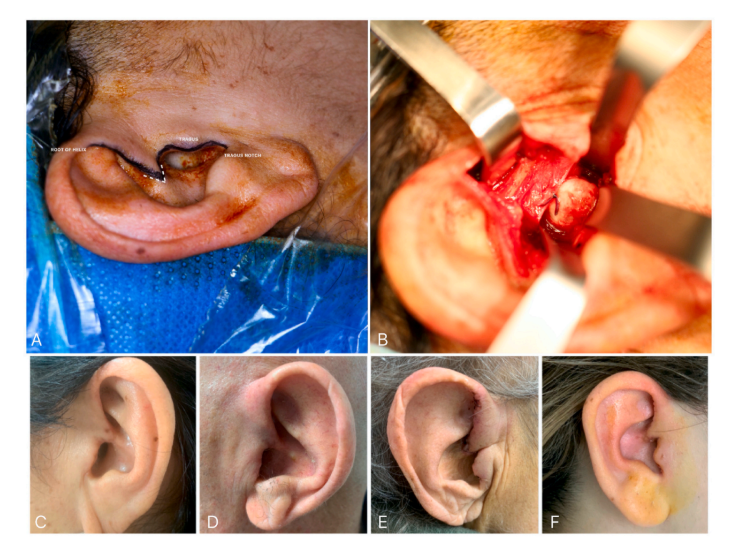A letter to the editor on “Root of helix inter tragus notch incision (RHITNI) for temporomandibular open surgery”
The most common temporomandibular joint (TMJ) open surgery approach is the preauricular incision described by Rowe in 1972. In recent years, the preauricular approach has gradually been substituted by a more cosmetic approach, the endaural approach. Many modifications of the endaural incision have been reported. However, they are generally described as “modified endaural approach” without clearly defining the particular modifications which lead to diverse problems (1): difficulty to clearly evaluate the benefits of a particular modification; (2) lack of details about the incision on the various TMJ open surgeries; (3) lack of adequate understanding of possible advantage among the different incisions; and (4) difficulty in dissemination of a particular surgical technique. In this article, the authors propose an appropriate nomenclature for a modification of the classical endaural approach: “Root of helix inter tragus notch incision (RHITNI)”. The RHITNI incision is marked from the inferior border of the root of the helix into the crux, performing a V shape following the inferior border of the tragus, and to finish in the ear notch (Fig. 1A).
A paraffin gauze is placed in the external auditory canal. Two per cent lidocaine local anesthetic with vasoconstrictor (1:100 000) is infiltrated in the subcutaneous tissues, creating a hydro-dissection in the helix, tragus and ear notch. The preauricular tissues are also infiltrated. The incision is made with a 15 blade scalpel. The skin and subcutaneous connective tissues are dissected with scissors, while the assisting sur- geon lifts the flap with a small double skin hook. The preference of the authors is to perform first the preauricular dissection with a mosquito forceps, then the temporal dissection using a pair of Metzembaun scissors until the superficial fascia of the deep temporal fascia is reached. The two zones are then connected using a mosquito forceps and monopolar cutting electrosurgical unit. Vessels are ligated if necessary. After good exposure of the temporal fascia, and with a monopolar, the fascia is opened from the zygomatic arch in a 45◦ degree direction. With a periosteal elevator, the zygomatic arch is exposed and the joint capsule is smoothly dissected. A T incision in the capsule is performed and the intended surgical procedure is performed with good surgical exposure (Fig. 1B). Closure is made in layers with vicryl 3/0 for subcutaneous tissues and monocryl 5/0 for the skin. Surgical glue is applied at the end, across the wound. Approximately twenty days after surgery, the glue is removed. No bandage or special care is required after surgery. No washing restrictions are recommended.
Many techniques and variations have been described in recent years, inundating the medical literature with modifications, creating confusion to surgeons and impossibility to conduct serious clinical trials to evaluate possible surgical benefits of each of these modifications. RHITNI is a clear and honest TMJ approach, with simple anatomic designation to describe our preferred technique. We have performed more than 50 open surgeries with this technique and we are satisfied. This technique allows complete anatomic control during surgery, adequate surgical exposure (Fig. 1B), low risks in damaging nerve structures, reduced need for vessels ligature, and outstanding cosmetic results when compared to the classic preauricular or endaural approaches (Fig. 1C-F). No ischemic complications of flap were observed. The low risks in damaging the temporal and zygomatic branches of facial nerve are mostly due to the RITNHI incision not extending inferiorly to the tragus, more posterior location than other incisions and a single-layered flap is used. The eventual risk of cartilage deformity is low, due to perichondrium preservation and no cartilage is transected. A clear definition of the different variations in endaural incision is necessary. In the authors’ opinion, RHITNI combines simplicity, safety, efficacy and cosmetic satisfaction. We strongly recommend its use and dissemination among TMJ surgeons. We also advise that for any future modifications of surgical techniques, the reports should give adequate anatomic explanations, and if possible with acronyms, to correctly identify the technique and to allow future clinical trials to measure any possible benefits of the new against other interventions.

References:
- N.L. Rowe, Surgery of the temporomandibular joint, Proc. Roy. Soc. Med. 65 (4) (1972) 383–388.
- W.J. Starck, G.A. Catone, S.I. Kaltman, A modified endaural approach to the temporomandibular joint, J. Oral Maxillofac. Surg. 51 (1) (1993) 33–37, https://doi. org/10.1016/S0278-2391(10)80385-4.
- C.A. Ruíz, J.S.S. Guerrero, A new modified endaural approach for access to the temporomandibular joint, Br. J. Oral Maxillofac. Surg. 39 (5) (2001) 371–373, https://doi.org/10.1054/bjom.2001.0662.
- G.J. Nishioka, J.E. Van Sickels, Modified endaural incision for surgical access to the temporomandibular joint, J. Oral Maxillofac. Surg. 45 (12) (1987) 1080–1081, https://doi.org/10.1016/0278-2391(87)90171-6.
- S. Balaji, Modified endaural approach for the treatment of condylar fractures: a review of 75 cases, Indian J. Dent. Res. 27 (3) (2016) 305, https://doi.org/10.4103/0970-9290.186235.
- M. Pau, M. Feichtinger, K.E. Reinbacher, P. Ivancic, H. K¨archer, Trans-tragal incision for improved exposure of diacapitylar and condylar neck fractures, Int. J. Oral Maxillofac. Surg. 41 (1) (2012) 61–65, https://doi.org/10.1016/j.ijom.2011.10.006.
- R.O.H.L. Davies, L. Cascarini, D. Coombes, G. Warburton, Two new surgical tech- niques to refine surgery around the ear: “the inviscision” and the external auditory meatus suture, J. Oral Maxillofac. Surg. 78 (2) (2020) 285, https://doi.org/ 10.1016/j.joms.2019.09.001.